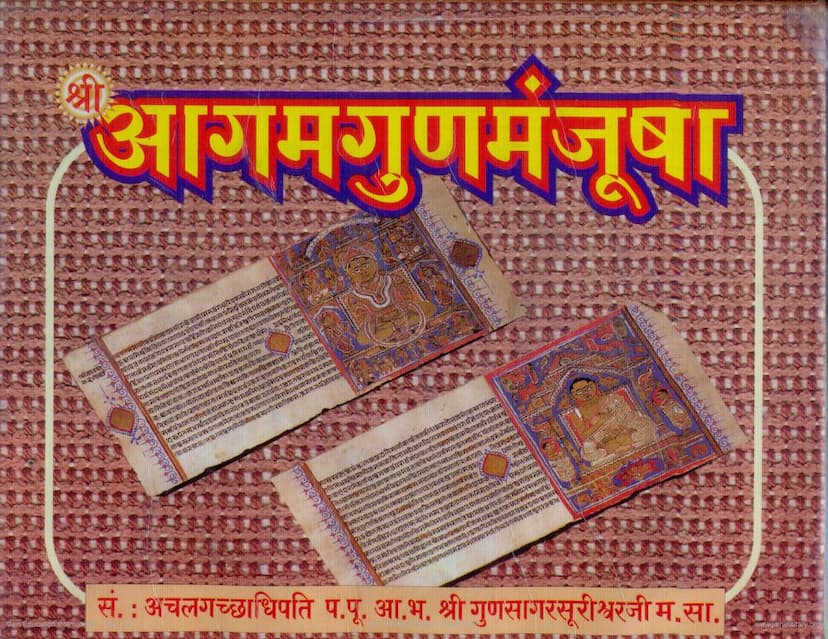Agam Guna Manjusha
Added to library: September 1, 2025

Summary
This is a comprehensive summary of the Jain text "Agam Guna Manjusha" by Gunsagarsuri, based on the provided pages from the catalog.
Book Title: Agam Guna Manjusha (आगमगुणमंजूषा) Author: Achalgachhadhipati Pu. Pu. A. Bha. Shri Gunasagarsurishwarji M. Sa. (presiding editor and inspirer) Publisher: Shri Jina Goyam Guna Sarvodaya Trust, Mumbai Publication Year: V.S. 2055 / V.S. 2525 / E.S. 1999 (as per page 16) and 2010-03 (as per page 2) - there seems to be a discrepancy between the publication year mentioned in the catalog link and on the pages themselves, with the latter indicating 2010. The content itself points to earlier compositions and compilation by the respected Acharya Gunasagar Suri. Catalog Link: https://jainqq.org/explore/002601/1
Summary of "Agam Guna Manjusha":
"Agam Guna Manjusha" is a profound compilation of Jain Agamas, curated and inspired by the revered Acharya Gunasagarsurishwarji Maharaj Saheb, the head of the Achalgachha sect. The book is essentially a compendium and exposition of the 45 Agamas, the sacred scriptures of Jainism, aiming to preserve and propagate their knowledge.
Key Aspects and Content:
-
Inspiration and Compilation: The work is inspired by Acharya Gunasagarsurishwarji Maharaj Saheb, who initiated the project of writing the 45 Agamas with their meanings. Though he is no longer physically present, his vast literary contributions and teachings continue to guide and inspire followers. The book is dedicated to the memory of Acharya Dharmamurti Suri Mahārāja Saheb, who was instrumental in documenting the 45 Agamas.
-
The 45 Agamas: The core of the book is dedicated to providing a concise introduction to each of the 45 Jain Agamas. These are categorized into:
- Eleven Anga Sutras: These form the primary body of scriptures, dealing with the fundamental principles of Jainism. The book outlines the content of each Anga, starting with Acharya Sudharma's role as the compiler of the Dvadasangi, of which eleven Angas are currently available.
- Twelve Upanga Sutras: These are considered subsidiary texts that elaborate on the themes presented in the Anga Sutras.
- Ten Prakirna Sutras: These are miscellaneous texts dealing with various subjects.
- Six Cheda Sutras: These texts focus on the rules and regulations for monks and nuns, dealing with penances and expiations for transgressions.
- Four Moola Sutras: These are foundational texts, including the Dashavaikalika Sutra and Uttaradhyayana Sutra, which are crucial for understanding monastic conduct.
- Two Chulikas: These are supplementary texts that provide further explanations or details.
-
Content of the Agamas: The summary for each Agama provides insights into its core themes. For instance:
- Acharanga Sutra (Page 7, 29-33): Focuses on the religious conduct of monks and lay followers, detailing principles of non-violence, self-control, and ethical living. It also includes descriptions of Lord Mahavira's hardships and the various hindrances he faced (Page 92).
- Sutrakritanga Sutra (Page 24, 27-28, 34-35): Discusses various philosophical viewpoints and refutes them, establishing the Jain perspective. It covers concepts like karma, the nature of reality, and the path to liberation.
- Sthananga Sutra (Page 23, 27, 35-37): This Agama is known for its systematic classification of Jain teachings based on numerical categories, ranging from one to potentially infinite. It details various aspects of Jain philosophy and practice.
- Samavayana Sutra (Page 23, 27, 37-41): This text focuses on classification and enumeration, providing details about various entities, their numbers, and their characteristics.
- Vyakhya Prajnapti Sutra (Bhagavati Sutra) (Page 23, 27, 41-48): The largest of the Angas, it presents a vast collection of dialogues between Lord Mahavira and his disciples, covering a wide range of spiritual, philosophical, and cosmological topics.
-
Guidance for Acalagachha: Page 16 highlights a "Shubh Sandesh" (शुभ संदेश - Holy Message) from Acharya Gunasagarsurishwarji Maharaj Saheb concerning the upliftment of the Achalgachha sect. It emphasizes reading, reflecting, and collectively working towards the sect's progress, especially in the current challenging environment.
-
Dedication: The book is dedicated to the memory of Acharya Dharmamurti Suri Mahārāja Saheb, acknowledging his pivotal role in the preservation of Agamic literature, including the transcription of manuscripts that are still found in Jain libraries.
-
Editorial and Collaborative Effort: The book is a result of a significant collaborative effort, involving inspiration from revered Acharyas and Munis of the Acalagachha, and contributions from various trusts and individuals who supported its publication. The publisher, Shri Jina-Goyam-Guna-Sarvodaya Trust, Amravati-Mumbai, played a crucial role. The publication process, including computer feeding of the Agamas and proofreading, involved multiple stages and the cooperation of many learned individuals.
-
Linguistic Approach: The book includes a "Saral Gujarati Bhavarth" (सरल गुजराती ભાવાર્થ - Simple Gujarati Interpretation) for the Agamas, making these complex texts accessible to a wider audience. The catalog link also provides an English summary, indicating the book's effort to reach a broader readership.
-
Historical Context: The text touches upon the historical importance of preserving the Agamas, noting that many ancient texts were written down due to the efforts of Munis like Acharya Dharmamurti Suri, despite the challenges of political instability.
Overall Significance:
"Agam Guna Manjusha" is more than just a collection of scriptures; it is a testament to the dedication of Acharya Gunasagarsurishwarji and the Acalagachha tradition in safeguarding and disseminating the profound wisdom of Jain Agamas. It serves as a valuable resource for Jains seeking a deeper understanding of their scriptures, presented in an accessible Gujarati translation, and highlights the continuous effort to preserve this rich spiritual heritage. The inclusion of a brief life sketch of Acharya Dharmamurti Suri and the dedication to Acharya Gunasagarsurishwarji underscore the lineage and importance of these spiritual guides.